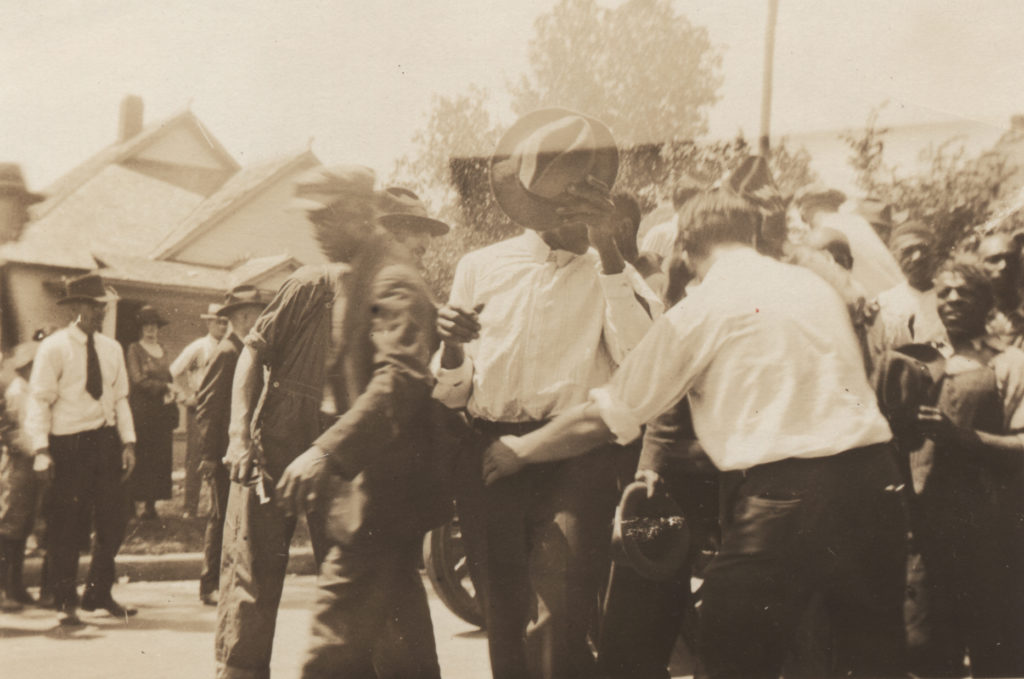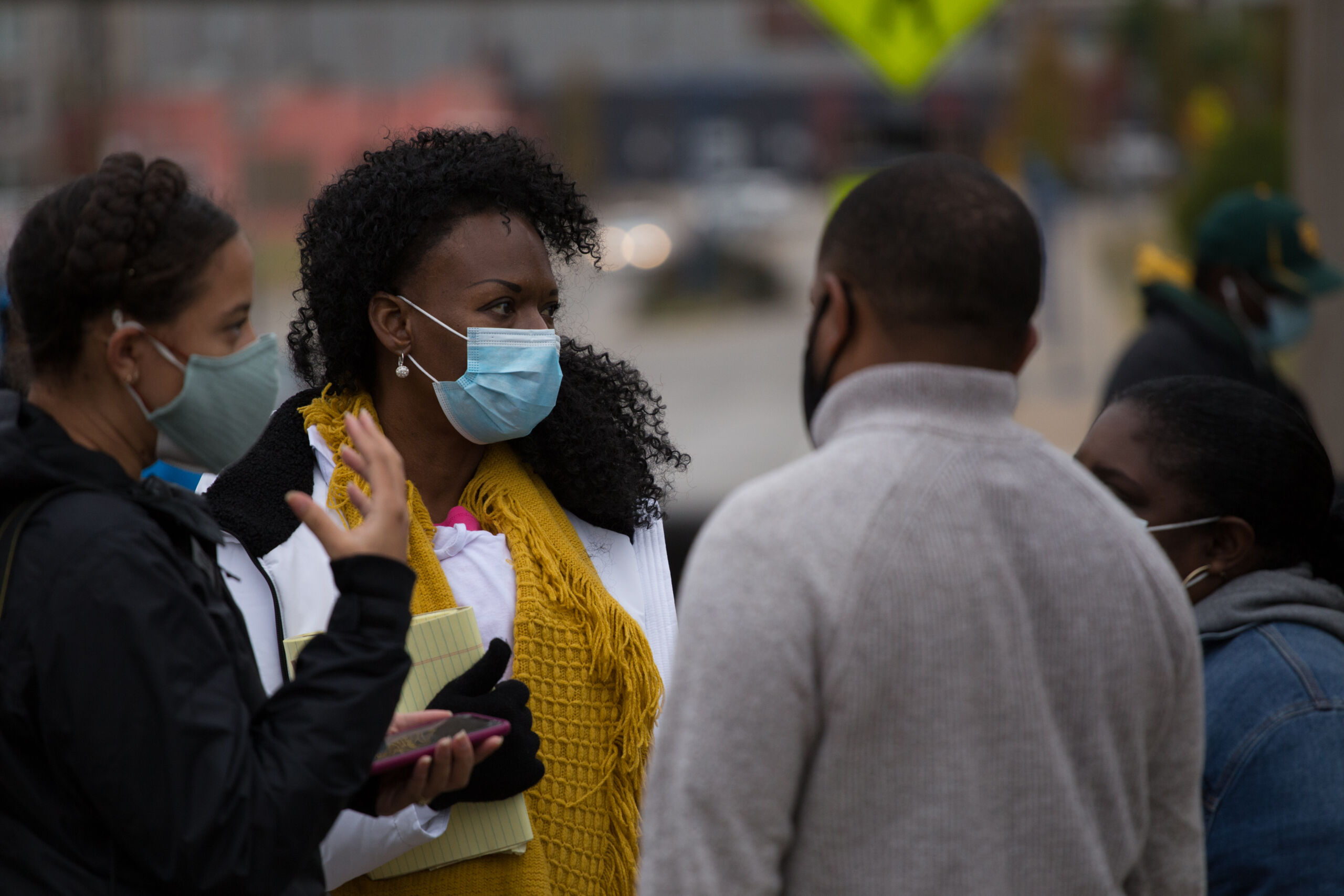
EDITOR’S NOTE: DeNeen L. Brown, an associate professor at the University of Maryland Philip Merrill College of Journalism and a longtime Washington Post reporter, is the focus of two documentaries on the 1921 Tulsa Race Massacre set to premiere over the next month.
PBS premieres the new film, “Tulsa: The Fire and the Forgotten,” on May 31 at 9 p.m. It examines the deadly Tulsa assault on the 100th anniversary of the racial-terror massacre in the context of other racial massacres and police killings, including the 2020 killing of George Floyd. The documentary focuses on Brown’s search for mass graves in Oklahoma.
National Geographic premieres its documentary, “Rise Again: Tulsa and the Red Summer,” on Nat Geo TV on June 18 at 9 p.m. The film will be available to stream on Hulu on Juneteenth (June 19). The documentary focuses on Brown as she travels the country, investigating massacres that occurred during Red Summer, a reign of terror that impacted more than 26 Black communities. Red Summer was a term coined by author and intellect James Weldon Johnson to describe the blood that flowed in the streets in cities and towns, including Washington, D.C.; Chicago; Omaha, Nebraska; and Elaine, Arkansas. In this Nat Geo documentary, directed by award-winning filmmaker Dawn Porter, Brown investigates the events and patterns of racial terror that led to the Tulsa Massacre.
The trigger event that sparked the 1921 Tulsa Race Massacre began on May 30, 1921, when Dick Rowland, a 19-year-old shoe shiner, walked into the Drexel Building, which had the only toilet available to Black people in a segregated Downtown Tulsa.
Rowland stepped into an elevator operated by Sarah Page, a white elevator operator. When the wire-caged elevator doors opened again, Sarah Page unleashed a piercing shriek. A department store clerk heard Page scream and saw Dick Rowland run and called the police.
It was unclear what happened in the elevator, but historians say Rowland may have accidentally bumped into Sarah Page. “The most common explanation is that Rowland stepped on Page’s foot as he entered the elevator, causing her to scream,” the Oklahoma Historical Society reported.
The next day, the Tulsa Tribune newspaper ran a headline, "Nab Negro for Attacking Girl in an Elevator." Hours later, a mob of hundreds of white people swarmed outside the Tulsa courthouse, where Rowland was taken after his arrest. The mob was confronted by Black men, including World War I veterans, who wanted to protect Rowland from being lynched, a tool of racial terror used frequently in the late 1800s and 1900s in America.

A struggle ensued between the white mob and the Black veterans. A shot was fired.
"Then all hell broke loose," a survivor recalled later.
Hundreds of white people marched on Greenwood in a murderous rage.
“They tried to kill all the Black folks they could see,” a survivor, George Monroe, recalled in the 1999 documentary “The Night Tulsa Burned.”
The white mob went on a two-day rampage, setting fire to hundreds of Black-owned businesses and homes in a district so prosperous it was dubbed the “Negro Wall Street” by philosopher Booker T. Washington.
Olivia Hooker, a massacre survivor, later called the massacre “The Catastrophe” to describe the 48 hours of fire and death that leveled “Black Wall Street” in Tulsa. Hooker was only 6 at the time she witnessed the mob that marched on Greenwood, burning houses and shooting people in the street. Her mother hid her and her siblings under a big oak dining-room table as their home was being ransacked.
“We could see what they were doing,” she told me during an interview. “They took everything they thought was valuable. They smashed everything they couldn’t take. My mother had [opera singer Enrico] Caruso records she loved. They smashed the Caruso records.”
White people killed as many as 300 Black people — dumping their bodies into the Arkansas River or burying them in mass graves, according to survivor accounts. The violence left more than 10,000 Black people without homes and 35 city blocks of homes and businesses in Greenwood smoldering.
No white person was ever arrested for the Tulsa Massacre. Many newspaper accounts of the rampage vanished. City officials, calling the massacre "an embarrassment" for a city calling itself "the oil capital of the world," tried to cover up the massacre, one of the worst single incidents of racial violence committed against Black people in U.S. history.
For nearly 100 years, the massacre was left out of textbooks even in Oklahoma.
White people, many of whom had taken photos and created postcards featuring them standing over dead bodies of Black people, went silent.
When Black people talked about it, it was mostly in whispers and only among family.
“Before my grandmother died, I asked her what happened. She began to whisper. She said, ‘They was killing Black people and running them out of the city,’ “ Vanessa Hall-Harper, Tulsa city council member, told me as I reported in Tulsa in September 2018. “I didn’t even know about the massacre until I was an adult. And I was raised here. It wasn’t taught in the schools. It was taboo to speak about it.”
I interviewed Hall-Harper and community activist Kristi Williams about the massacre and its aftermath. They took me to sites in Tulsa where Black people were killed. They took me to the street in Tulsa where Black survivors were required to march at gunpoint with their hands raised and crowded into “internment camps” throughout the city.
I was born in Oklahoma only four decades after the Tulsa Race Massacre. My father, a descendant of a Creek freeman, is from Oklahoma. My paternal great grandmother lived in Tulsa. My paternal grandmother was born in the all-Black town of Boley, Oklahoma, famous for its Black rodeo. We know now that during the massacre, many Black people fled Tulsa for surrounding Black towns.
I don’t remember when and where I first heard about the massacre, but when I lived in Tulsa as a teenager, the place was heavy and struck me as haunted, as though the very ground had a story to tell.

Many years later, after I’d gone off to college and then after graduating, and on to Washington, where I became a reporter for The Washington Post, the story of the massacre on the land of my birth stayed with me, filed away in the recesses of my memory.
In April 2018, The Washington Post sent me to Montgomery, Alabama, to cover the opening of the memorial to lynching victims. It was there in Montgomery that I came face to face in a physical way with the horror of racial terror. The National Memorial for Peace and Justice stands on a grassy mound in Montgomery. From the entrance, visitors walk up a winding path to the memorial. There, each visitor is confronted by vertical tombs upon which the names of thousands of lynching victims are etched into metal.
I remember walking up the hill to the memorial. The names of those Black people who had been lynched hit me directly in the face. I will never forget that reporting trip. I will never forget walking amid the vertical columns, between them and around them and under them until they rose above my head. I recall frantically taking notes in my reporter's notebook, scribbling down the stories that were on the surrounding walls. The stories explained why some people were lynched: Drinking from a white family’s well. A Black woman scolding white children who threw rocks at her. A Black man accidentally bumping into a white woman.
Those stories were seared in my memory. The memorial was profound and eerily beautiful.
After filing a story about the lynching memorial for The Post, I flew from Montgomery to Washington, D.C. Then on to Kansas, where I attended a board of trustees meeting at the University of Kansas journalism school. I hit the road again, driving South through the Flint Hills, to Wichita, Kansas, to visit my mother and siblings. Then hit the highway again, driving through tornado alley and across the Cimarron Turnpike to Tulsa to visit my father and stepmother.
One afternoon, I asked my father to go with me to visit what remained of Black Wall Street. We had a lunch of fried catfish, greens and sweet potatoes at Wanda’s Cafe, a soul-food café and one of the last Black-owned businesses on Black Wall Street. I remember looking around at the street, astonished that there was so much new development there.
Having just completed the reporting trip to Alabama, I wondered why Tulsa’s Black Wall Street did not have a similar monument. To me, Black Wall Street was sacred ground. None of the new development seemed related to the Black history of the place. I noticed a minor league baseball stadium had been built in the heart of the district, not far from a new apartment building and a yoga studio.
“Oh my God,” I thought. “Black Wall Street is being gentrified."
Upon my return to Washington, I told my assignment editor, Lynda Robinson, what I noticed on Black Wall Street and Post editors sent me back to see what I could find as a reporter. On the ground in Tulsa, I talked to Black descendants of the Tulsa Race Massacre. They told me that without truth and reparations, the wound of the massacre would never heal. They still wondered why the recommendations of the Tulsa Race Riot Commission of 1999 -- to pay reparations to massacre survivors and their descendants, and to search for mass graves -- had never been completed.
My story about the mass graves was published in The Washington Post in September 2018. Two days later, Tulsa’s mayor, G.T. Bynum, announced the city would reopen an investigation into mass graves with the potential of identifying the remains of victims.
Bynum told me he considered the massacre an unsolved murder case.
“We owe it to the community to know if there are mass graves in our city,” Bynum said. “We owe it to the victims and their family members. We will do everything we can to find out what happened in 1921.” In October 2020, the City of Tulsa uncovered a mass grave in the city-owned Oaklawn Cemetery. Scientists will continue to excavate the site on June 1, 2021.
Documentaries uncover truth
In 2019, I was contacted by Jonathan Silvers, a filmmaker in New York, who requested to follow me around with his cameras as I continued to report for The Washington Post and write incremental news stories about the search for mass graves in Tulsa.
That film, "Tulsa: The Fire and the Forgotten," will be released by PBS on May 31, 2021, the 100th anniversary of the massacre.
The camera followed me as I talked to descendants of massacre victims — and probed how their families’ historic experience affected their lives in today’s America. Through the historical lens of white violence and Black resistance, the film explores issues of generational trauma and calls for reparations by massacre survivors and their descendants.
I am listed as a filmmaker, reporter and producer of the PBS film. Here is an IndieWire story about the film.
I am also the focus of another production, National Geographic’s "Rise Again: Tulsa and the Red Summer," which will be released June 18, 2021, on Nat Geo TV and on June 19, 2021, on Hulu.
Here is a Hollywood Reporter story explaining the documentary.
As an associate professor at the UMD Philip Merrill College of Journalism, I often tell my students that journalism has the power to change the world. I lecture about how journalists must pursue the truth, as closely to the truth as it can be ascertained.
In classes, we talk about the importance of asking questions, the importance of reporting, the importance of gathering facts and talking to sources whose voices are not often heard in newspapers. We discuss the journalism mandate to hold the powerful accountable -- and the old journalism adage, “comforting the afflicted and afflicting the comfortable.”
As a news feature writer, a journalism professor and a working journalist, my journalism goals continue to be imparting the truth to my students and seeking the truth as a reporter. It is my hope these documentaries uncover the truth of the massacres and racial-terror violence that impacted so many Black people in this country’s history.
It is my hope the films afflict the comfortable and comfort the afflicted. May the truth about what happened nearly 100 years ago during a reign of terror that includes “Red Summer” and the 1921 Tulsa Race Massacre be unleashed.
